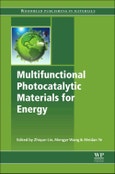Multifunctional Photocatalytic Materials for Energy discusses recent developments in multifunctional photocatalytic materials, such as semiconductors, quantum dots, carbon nanotubes and graphene, with an emphasis on their novel properties and synthesis strategies and discussions of their fundamental principles and applicational achievements in energy fields, for example, hydrogen generation from water splitting, CO2 reduction to hydrocarbon fuels, degradation of organic pollutions and solar cells. This book serves as a valuable reference book for researchers, but is also an instructive text for undergraduate and postgraduate students who want to learn about multifunctional photocatalytic materials to stimulate their interests in designing and creating advanced materials.
Please Note: This is an On Demand product, delivery may take up to 11 working days after payment has been received.
Table of Contents
1. Introduction: A perspective-Multifunctional photocatalytic materials for energy Zhiqun Lin, Meidan Ye, Mengye Wang 2. Metal oxide powder photocatalysts Mohammad Mansoob Khan 3. Metal oxide electrodes for photo-activated water splitting Davide Barreca 4. Theoretical insights for improved photocatalytic activity Victor Antonio de la Pena O'Shea 5. Energy band engineering of metal oxide for enhanced visible light absorption Jiangtian Li 6. Graphene photocatalysts Luisa Maria Pastrana Martinez Sr. 7. Carbon Nitride photocatalysts Hongqui Sun 8. Graphene-based nanomaterials for solar cells Syed Farooq Adil, Mujeeb Khan 9. Metal-based Semiconductor nanomaterials for solar cells Dr. Wenxi Guo Sr. 10. Metal-based Semiconductor nanomaterials for photocatalysis Raffaele Marotta, Roberto Andreozzi, Ilaria Di Somma, Danilo Russo, Laura Clarizia Sr. 11. Conjugated polymer and nanocrystal nanocomposites for photocatalytic hydrogen production and organic contaminants degradation Bhaghavathi Parambath Vinayan, Eswaraiah Varrla, Rupali Nagar 12. Hybrid noble metal and semiconductor nanocomposites for plasmon-mediated photocatalysis Yuekun Lai 13. Hybrid Z-scheme nanocomposites for photocatalysis Kazuhiko Maeda 14. Ferroelectrics for photocatalysis A Chithambararaj








